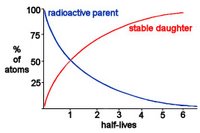radiometric dating

Each radioactive isotope (atoms of the same element differing in neutron number) has its own unique half-life, which is the time required for half of the parent radioactive element to decay to a daughter product. Radioactive decay occurs at a constant exponential or geometric rate, so half of parents will decay to daughters (1:1) in one half life and one half of the remaining parents will decay in the next half life (1:3).
Table Radiometric Dating
Geologists estimate the length of time over which decay has occurred by measuring the ratio of radioactive parent element and stable daughter elements. Radioactive elements tend to become concentrated in the residual melt during the crystallization of igneous rocks, so traces of a radioactive mineral in an igneous rock will 'set the clock' at the time of cooling/solidification.
K-40 decays to Ar-40 (a gas trapped in the rock) with a half-life of 1.25 billion yrs and is found in:
amphiboles
glauconite (greensand, rare)
muscovite
potassium feldspar (orthoclase)
U-235 decays to Pb-207 with a half-life of 704 million years, and the much more abundant U- 238 decays to Pb-206 with a half-life of 4.47 billion years. Uranium can be found in:
apatite
monazite
sphene
urananite
zircon
Sedimentary rocks comprise grains with 'clocks' set to the time of cooling of the parent igneous rocks. So radiometric dating of sedimentary rocks is meaningless concerning date of formation unless the sediment contains unusual minerals such as glauconite that formed on the seafloor as the rock was cemented.
The spontaneous fission of uranium creates fission tracks in the crystal lattice of minerals that contain U. Fission tracks can be visualized and counted in micas, tektites, and natural volcanic glass.
◘ Hadean ◘ Archaean ◘ Archaean supercontinents ◘ Proterozoic ◘ Phanerozoic ◘ geologic provinces ◘ mantle plumes
USGS Geologic Time: Radiometric Time Scale
tags [Paleogeology] [radiometric dating] [fission tracks] [geological dating]
Labels: fission tracks, half-life, isotope, radiometric dating






































